Guide to securing cargo on ferries with lashing points
Ferry transportation in the autumn and winter period should be conducted with special caution due to unfavourable weather conditions. We have prepared a short guide for you on how to secure your load in accordance with the applicable rules.
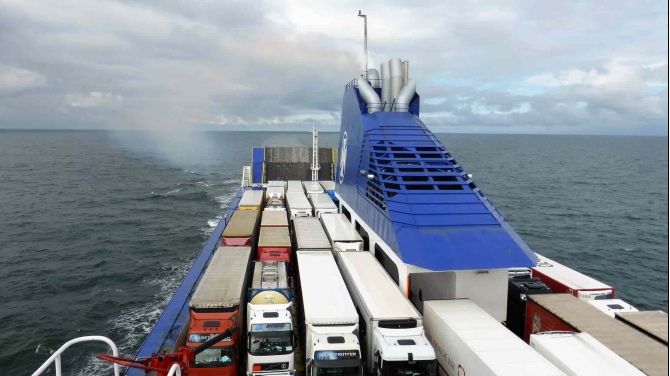
Anchorage points, lashing points, securing points
Obtaining approval for transportation by ferry depends on the correct fastening of the cargo. In order to do so, it is important that a vehicle is equipped with lashing points. A lash point is a type of anchorage point. To ensure the safety of the transported cargo and vehicles, the vehicle has to be equipped with the required number of lashing points.
Securing cargo - general guidelines for securing semi-trailers
Listed below are some general guidelines to assist you in properly securing your cargo on a ferry. Although they apply throughout the year, they are particularly important during periods of severe weather.
Despite routinely using the services of ferry operators and being familiar with the rules of transport, it is crucial to make sure the goods are properly arranged and secured with lashings. This is especially important during autumn and winter as the weather conditions worsen.
In order to ensure the safety of the load, special holders (lashing points) must be attached to the chassis. During transport, the semi-trailer not coupled to the vehicle should be connected with the help of tensioners attached to the lashing points. Under sea conditions, landing legs are not capable of supporting the load and trailer. In the absence of appropriate lashing points and trestles, a vehicle will not be permitted to be transported.
Certain ferry operators may require more detailed safeguards, which are always in accordance with international regulations on sea transport safety.
All details are included in the Marine Guidance Note, No. 418, issued by the Coast and Maritime Guard Agency, which is based on regulations of the International Maritime Organization (IMO).
How many lashing points are required?
The number of securing points required varies depending on the size and weight of the vehicle.
All units with a maximum permissible weight of more than 3.5 tonnes must be equipped with the appropriate number of lashing points on each side of the trailer. According to the guidelines set out in the IMO regulations, there must be no less than 2 and no more than 6 lashing points on each side of the semi-trailer. The number of lashing points was defined very precisely, taking into account the gross vehicle weight (GVM).
For vehicles weighing between 3.5 and 20 tonnes, 2 lashing points are required on each side of the semi-trailer (4 in total), for units weighing more than 20 tonnes but less than 30 tonnes, there should be 3 such points (6 in total), while for trucks weighing more than 30 tonnes but less than 40 tonnes, 8 lashing points are required (4 on each side).
Please note, however, that these guidelines only apply to vehicles shorter than 9 m. For vehicles longer than 9 m, the minimum number of lashing points on each side is 4.
It should also be remembered that two additional lashing points should also be located at the front of the car's cabin, one on each side.
A detailed drawing of the attachment points is below.
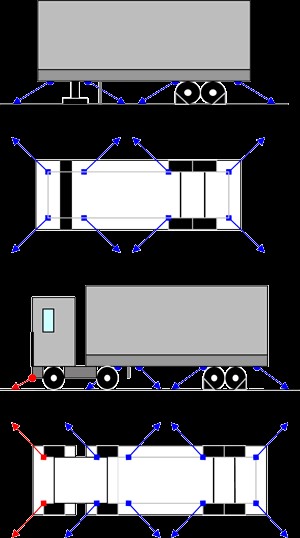
What should the lashing points look like?
Each lashing point must be clearly colour coded and fixed so that it is fully accessible for rope attachment. Here are some examples.
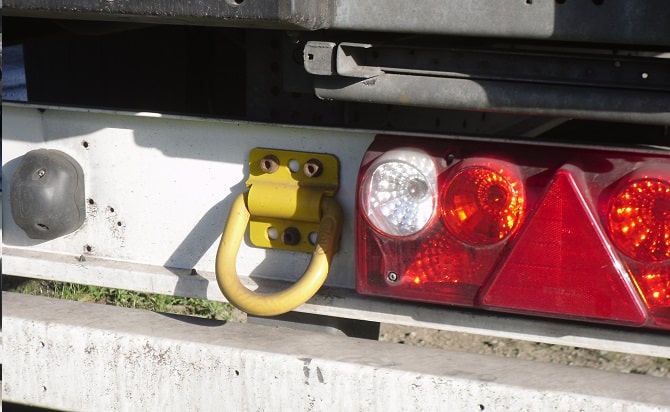
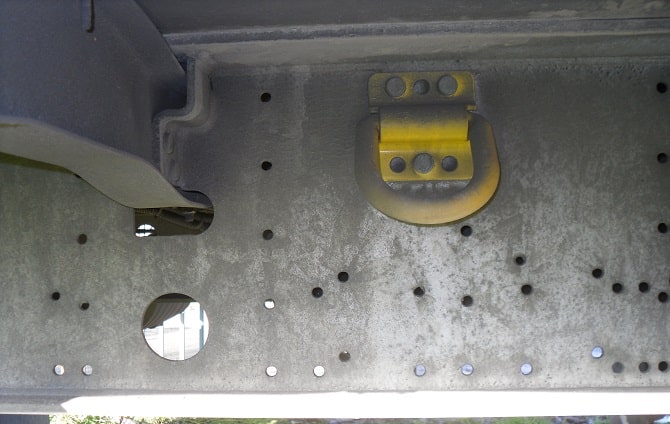

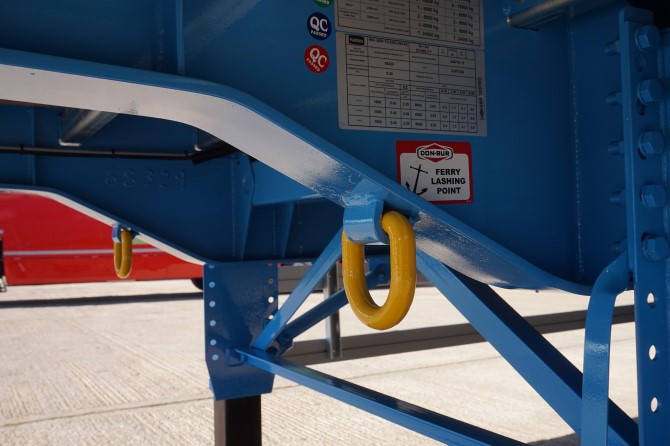
The load must be stable enough to absorb shocks and any inconveniences arising during transport in unfavourable weather conditions. Each securing point should have an internal free passage of at least 80 mm. The gap does not have to be circular.

The maximum securing load (MSL) of each point must be less than 100 kN. Each of the securing points should be made of a suitable material with the required flexibility and mechanical properties to be able to tie the load so it does not move. Only one hook can be attached to each hole and support one lashing line. The rope must be stretched over the hook in such a way that the angle between the rope and the edge of the vehicle is between 30 and 60 degrees.
Cargo securing lashing points on ferries to Sweden
Our team contacted each of the four ferry operators offering crossings from Poland and asked about their guidelines for securing semi-trailers. Here's what their representatives told us.
Stena Line
The ferry operator adheres to the recommendations contained in the "Code of Safe Practice for Cargo Stowage and Securing". It is required that each truck (including semi-trailers without tractor units) has to be equipped with at least four approved ferry lashing points on each side of the vehicle. This should ensure that it is loaded on the deck in a safe and appropriate manner for sea transportation.
Polferries
On one of the ferry operator's ferries, the Wawel ferry, semi-trailers should be equipped with certified lashing points for sea transport or factory-made holes for attaching hooks of lashing straps – otherwise, the operator is forced to lash loads to the structure of the semi-trailer's frame, which may, in extreme cases, cause damage to the structure of the semi-trailer.
Unity Line
The ferry operator told us that the load must be evenly distributed over the entire semi-trailer, which should be equipped with lashing hooks - the crew will take care of the rest. The permissible height of the semi-trailer varies depending on the ferry on which the sailing is made. The safest height for the semi-trailer is one not exceeding 4.2 m. For non-standard dimensions, please ask directly.
TT-Line
Only vehicles equipped with lashing points are allowed to be transported. This principle applies not only to vehicles transporting dangerous goods. It is recommended to secure loads regardless of the weather to ensure the optimal safety of transport on the ferry.
UPDATE: Securing lashing points on DFDS Seaways' ferries
Ferry operator DFDS Seaways reminds that heavy goods vehicles are intended to be shipped on ro-ro vessels, should be equipped with a sufficient number of securing points.
Standards for the location of securing points on road vehicles are described in Standard EN 29367-1:1994 and ISO 9367-1:1994.
Each point should be capable of accepting only one lashing and should be painted with visible colour. Each side of the vehicle should be provided with the same amount of securing points, which is supposed to be not less than two or more than six.
The table below show minimum number of securing points depending on gross vehicle mass.
| Gross vehiclemass [tonnes] | Minimum number of securing points on each side of the vehicle |
| 3,5 ≤ mass ≤ 20 | 2 |
| 20 < mass ≤ 30 | 3 |
| 30 < mass ≤ 40 | 4 |
Securing points should never be attached to bumper or axles. The internal free passage of a securing point should be not less than 80 mm but it does not need to be circular in shape.
Will the ferry operator take your vehicle without lashing points?
The last word belongs to the captain.
In addition to the proper securing of the semi-trailer, it should also be remembered that the final decision on admitting or rejecting the vehicle for transport is made by the captain. It is the responsibility of the vehicle operators to ensure that the vehicle and cargo are secured in the best possible way during ferry transport.
If there is a topic you would like to learn more about, please e-mail us at bok@promy24.com or call +48 502 310 375.
Information collected by:
M. Ratajski


